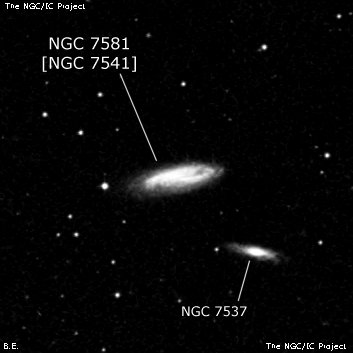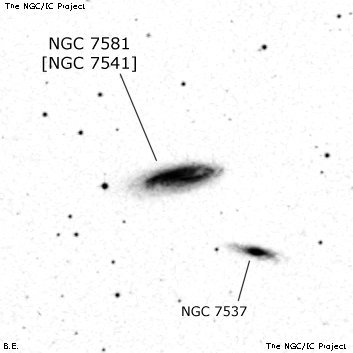NGC/IC Project Restoration Effort
(This is a very very beta version)
NGC7581


Basic Information
Location and Magnitude
Right Ascension: 23:14:43.2
Declination: +4:32:4
Constellation: PSC
Visual Magnitude: 11.7
Historic Information
Discoverer: Tuttle
Year of discovery: 1875
Discovery aperture: 26.0
Observational
Summary description: vF, mE, * 12·13 close f
Sub-type: SBc
Corwin's Notes
=====
NGC 7581 may be NGC 7541. Dreyer credits the object to Holden, but it is not
in either of the lists in the Washburn Observatory Publications that Dreyer
credits in the NGC. Nor does Dreyer give a reference in the GC Supplement
where the object first appears. If Holden published a note about the object,
it must have been in the time between the GC's appearance in 1864 and the
publication of the Supplement in 1878. Perhaps someone could check the
appropriate journals of the time (AN, MN, The Observatory, AJ, and so forth).
In any event, the identity with NGC 7541 was first suggested by Reinmuth.
From Die Nebel Herschel, it was picked up by Carlson, then RC1, and RNGC. The
identity is reasonable: aside from being called "very faint," the remainder
of the GC/NGC description "much extended, star 12-13 close following" is
accurate. However, the position is 3 minutes of time off in RA, and 8 arcmin
in Dec. These don't seem to suggest simple digit errors, though they could
be if the declination error is 10 arcmin, with the 2 arcmin remainder
accounted for by random error.
I've put a question mark on the identification because of the position
mismatch and the lack of a reference.
-----
Note added in August 2007: Wolfgang found the relevant observation in the
"Astronomical and Meteorological Observations made during the Year 1875 at the
United States Naval Observatory", Vol. 15, 1878. On page 285 is this curious
note: "1875 Jan. 11. Nebula (nova). In looking for Encke's Comet, found a
vF, elongated nebula [alpha] = 23h 11m.4 [delta] = +3d 59. Tuttle." Assuming
that this is for the equinox of 1875, this precesses to exactly the NGC
position.
But it is curious indeed that the observation is credited to Horace P. Tuttle
rather than to Edward S. Holden. Not only is Tuttle's name given explicitely
in the Remarks column, but his initial appears in the Observer column as well.
On the other hand, Holden is credited with observing a "Satellite of Neptune"
on the same night, so perhaps the person who prepared the table of
observations with the 26-inch refractor misattributed the observation. In his
2010 book, however, Wolfgang makes no mention of this possibility, apparently
accepting Tuttle as the nebula's discoverer.
If that is the case, then Wolfgang argues that Holden must have sent a letter
to Dreyer correcting the attribution, and adding the note about the star close
following. If that is in turn true, then we need to search Dreyer's records
(in Oxford, Armagh, or the RAS Library in London?) for that letter.
Steve's Notes
=====
NGC 7581
See observing notes for NGC 7541.



